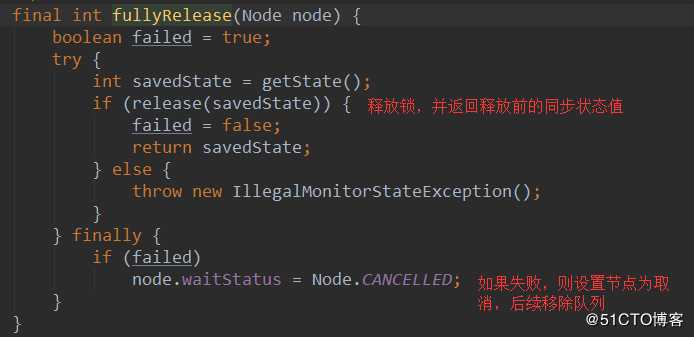多线程(十一AQS原理-ReentrantLock的条件队列Condition)
Posted
tags:
篇首语:本文由小常识网(cha138.com)小编为大家整理,主要介绍了多线程(十一AQS原理-ReentrantLock的条件队列Condition)相关的知识,希望对你有一定的参考价值。
1、Condition介绍1.1 Condition是对线程的wait,notify的增强
1.2 在ReentrantLock中他的实现类是AQS中的ConditionObject,实现了Condition接口,利用AQS的节点,实现了条件队列。



2、案例分析
2.1 说明:Thread-1获取锁,然后await,释放锁;Thread-2获得锁,唤醒Thread-1,释放锁;Thread-1重新获取锁,释放锁。
2.2 代码
2.2.1 Thread-1
import java.util.concurrent.locks.Condition;
import java.util.concurrent.locks.ReentrantLock;
public class Task1 implements Runnable
private ReentrantLock lock;
private Condition con;
public Task1(ReentrantLock lock, Condition con)
this.lock = lock;
this.con = con;
@Override
public void run()
try
lock.lock();
System.out.println(Thread.currentThread().getName() + "获取到锁....");
System.out.println(Thread.currentThread().getName() + "开始阻塞....");
con.await();
System.out.println(Thread.currentThread().getName() + "重新获取锁,继续执行....");
Thread.sleep(2000);
catch (InterruptedException e)
e.printStackTrace();
finally
System.out.println(Thread.currentThread().getName() + "释放锁....");
lock.unlock();
2.2.2 Thread-2
import java.util.concurrent.locks.Condition;
import java.util.concurrent.locks.ReentrantLock;
public class Task2 implements Runnable
private ReentrantLock lock;
private Condition con;
public Task2(ReentrantLock lock, Condition con)
this.lock = lock;
this.con = con;
@Override
public void run()
try
lock.lock();
System.out.println(Thread.currentThread().getName() + "获取到锁....");
System.out.println(Thread.currentThread().getName() + "唤醒Thread-1....");
con.signal();
Thread.sleep(2000);
catch (InterruptedException e)
e.printStackTrace();
finally
System.out.println(Thread.currentThread().getName() + "释放锁....");
lock.unlock();
2.2.3 启动文件
import java.text.ParseException;
import java.util.concurrent.locks.Condition;
import java.util.concurrent.locks.ReentrantLock;
public class Main
public static void main(String[] args) throws ParseException, InterruptedException
ReentrantLock lock = new ReentrantLock(true);
Condition condition = lock.newCondition();
Thread t1 = new Thread(new Task1(lock,condition),"Thread-1");
Thread.sleep(2000);
Thread t2 = new Thread(new Task2(lock,condition),"Thread-2");
t1.start();
t2.start();
2.2.4 运行结果

3、源码分析
3.1 获取锁的源码在上一篇已经分析过了,来看await操作:
public final void await() throws InterruptedException
if (Thread.interrupted())
throw new InterruptedException(); //判断线程是否中断,中断则抛出异常
Node node = addConditionWaiter(); //当前线程包装节点,放入【条件对列】,注意不是【等待队列】
int savedState = fullyRelease(node);//释放锁资源
int interruptMode = 0;
while (!isOnSyncQueue(node)) //如果当前节点不在【等待队列】
LockSupport.park(this); //在这里阻塞,等待被唤醒,后面代码唤醒前不执行
if ((interruptMode = checkInterruptWhileWaiting(node)) != 0)
break;
if (acquireQueued(node, savedState) && interruptMode != THROW_IE)
interruptMode = REINTERRUPT;
if (node.nextWaiter != null) // clean up if cancelled
unlinkCancelledWaiters();
if (interruptMode != 0)
reportInterruptAfterWait(interruptMode);
3.1.1 await()方法会释放当前线程持有的锁,就是fullyRelease方法的作用

3.1.2 线程A释放了锁,并进入条件对列,处于阻塞状态。
3.2 Thread-2获取到锁后,调用signal方法唤醒Thread-1


final boolean transferForSignal(Node node)
/*
* If cannot change waitStatus, the node has been cancelled.
*/
//将节点的状态修改为0,从【条件队列】节点状态转换为【等待队列】默认节点状态0,节点可以插入【等待队列】
if (!compareAndSetWaitStatus(node, Node.CONDITION, 0))
return false;
/*
* Splice onto queue and try to set waitStatus of predecessor to
* indicate that thread is (probably) waiting. If cancelled or
* attempt to set waitStatus fails, wake up to resync (in which
* case the waitStatus can be transiently and harmlessly wrong).
*/
Node p = enq(node);//将节点插入【等待队列】
int ws = p.waitStatus;
if (ws > 0 || !compareAndSetWaitStatus(p, ws, Node.SIGNAL)) //将前驱节点设置为可唤醒状态
LockSupport.unpark(node.thread);//唤醒节点,也就是Thread-1
return true;
3.3 Thread-2释放锁
3.3.1Thread-2释放锁,会唤醒【等待队列】的首节点,参看上一篇介绍(unparkSuccessor方法)
3.3.2 Thread-1继续执行

以上是关于多线程(十一AQS原理-ReentrantLock的条件队列Condition)的主要内容,如果未能解决你的问题,请参考以下文章